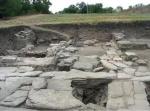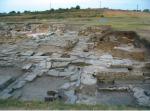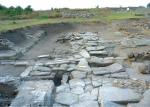Summary (English)
DEULTUM (Hristo Preshlenov – hristo.preshlenov@abv.bg) The decumanus and the cardo with the adjacent buildings were explored. Both streets bordered from the south and the west the thermae in the center of Deultum explored during the 1980s. The colonnade on the southern stylobate of the decumanus and to the west of the streets junction was discovered. It was reconstructed before the end of the 4th century AD. A building adjoining the colonnade was documented and burned debris with a coin of the second half of the 4th century AD was found inside. Two more occupation phases were documented to the west of the junction. The first one was evidenced in a room accommodating dolia with grain. Palestinian amphorae and coins of Arcadius minted in AD 401 – 408 were found inside. The second phase was evidenced in a stratum, containing charcoal, burned sun-dried and terracotta bricks, roof-tiles and coins of Justin II and Phocas. A place for stirring mortar was discovered above the cardo, containing a follis of Justinian I minted in AD 561 – 562. Six bases of an Early Byzantine colonnade were discovered to the east of the junction. Burned debris was discovered in two rooms adjoining the colonnade and coins of AD 425 – 455 were found on the decumanus. After the first fire that occurred before the end of the 4th century AD reconstructions were carried out. The streets were reconstructed after the construction of the Early Byzantine fortress that occurred after AD 457. Two columns built of bricks were discovered, belonging to the colonnade of the decumanus reconstructed during AD 450 – 475. In that period the decumanus was narrowed from its northern side by the construction of a fountain in front of the nymphaeum. Bronze coins of AD 348/358 – 401/403 were found in the drain under the cardo and the flowing drain under the decumanus. Until the reconstruction during AD 450 – 475 the cardo was 8.40 m wide with a kerbstone and a stylobate. The decumanus was narrowed by the construction of a building; burned sun-dried bricks and amphorae of the second half of the 5th century AD were found inside. A ramshackle room of the 7th – 8th centuries AD was discovered at the junction.
- Hristo Preshlenov - Archaeological Institute with Museum
Director
Team
Research Body
- Archaeological Institute with Museum






![Download [PDF]](/excavation/skins/fasti/images/results/download_sml.png)

